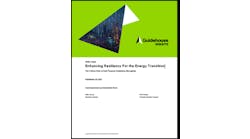We continue “Facets of the Edge,” a Data Center Frontier series examining the many components of edge computing, and the infrastructure needed to support them.
MOUNTAIN VIEW, Calif. – Can you imagine of world of powerful mobile devices unencumbered by limitations on compute power and data? Some technologists have, and believe edge computing will unleash powerful new technologies.
At the recent Edge Computing World conference, these edge believers shared a vision of a future transformed by edge computing. Amid diverse views about the prospects for edge computing, here is a look at the bullish view, as shared by veteran analysts, investors and technologists.
“I think we’re entering a seismic paradigm shift,” said Chetan Sharma, a telecom industry consultant and futurist, who projects the edge economy to reach $4.1 trillion by 2030. “A number of technologies are coming together to create this experience that the world has never seen before.
“Digital tools are meeting new business models, and it’s happening everywhere,” said Sharma. “The traditional architecture will not be able to handle the applications we are considering.”
A World Transformed by AI, Edge and AR
Future Ventures founder Steve Jurvetson believes powerful new mobile devices will drive demand for ubiquitous edge computing.
“In the next few years I think we’ll have a massive switch to the edge,” said Jurvetson, a veteran venture capitalist and chip engineer who was an early investor in Tesla and SpaceX. “AI is potentially going to dominate all other forms of programming, and AI needs the edge. It’s difficult to build an intelligent system without an edge presence.
“Once you have edge intelligence, these systems proliferate around the planet, like a sensory cortex,” he added. “The boundaries of the network are where the value is – the edge and the core of the network. Everything in between will be commoditized.”
One of the most profound impacts of edge computing could be its enablement of immersive technologies like augmented reality and virtual reality. Amy Peck, the Senior Director of Enterprise Content at HTC Vive Studios, shared AR technologists’ view of a “world painted with data” that creates new frontiers in digital experience.
Amy Peck, the Senior Director of Enterprise Content at HTC Vive Studios, foresees a “tsunami of emerging technology” driving demand for edge computing. Peck spoke at Edge Computing World in Mountain View, Calif. (Photo: Rich Miller)
“2025 may be the tipping point for immersive tech,” said Peck. “A tsunami of technology is coming at us. We have to look at this convergence. We are racing toward this future, and I think we really need to think bigger.
“The use cases are endless,” she continued. “There isn’t an industry that won’t be able to use these immersive technologies. AR is the next ubiquitous computing platform. The real and the virtual will merge, and we will move seamlessly into and out of these realms.”
New Report Projects Massive Future Growth
As we noted in our 2020 forecast (Eight Trends That Will Shape the Data Center Industry in 2020), the economics of edge computing will come into sharp relief in 2020. Edge computing is a trend that will play out over many years, and has been boosted by enthusiasm over technologies with long deployment horizons.
But the journey to the huge, distributed network of the future has been an uneven one. Deployment schedules for edge data centers have lagged initial projections, and some industry observers and analysts say the edge enthusiasm is getting ahead of the market. Meaningful debates persist around business models.
But enthusiasm remains high for the long-term future of edge, as seen in a new research report from a consortium of edge-focused companies.
Jim Davis of Edge Research Group presents findings from the State of the Edge 2020 report at the recent Edge Computing World conference. (Photo: Rich Miller)
The State of the Edge 2020 report projects that edge investment will accelerate after 2024, with the deployed global power footprint of the edge IT and data center facilities forecast to reach 102,000 megawatts by 2028, with annual capital expenditures of $146 billion.
“We’re moving from this era of humans communicating to an era of machines communicating,” said Jim Davis of Edge Research Group, one of the report’s authors. “We have more and more devices creating more and more data. These experiences will require a different Internet.”
“Edge computing represents a long-term transformation of the Internet that could take decades to fully materialize,” said the report, which was released in December. “As more and more machines come online, businesses will seek to apply the power of server-side processing to their behaviors. This will require an edge-enabled internet that operates at machine speeds. As we re-architect the Internet to reduce latency and jitter on the round-trip path, we create a platform to satisfy the demand for machine-speed edge applications.”
The State of the Edge project was created to help define edge concepts and business cases and is backed by a consortium of edge-focused companies including ARM, Ericsson, Vapor IO, and Packet, with analyst support from Structure Research and Edge Research Group.
Enterprises Shift to Implementation Mode
At Edge Computing World, several veterans of the data center industry said edge represents a significant business opportunity.
“I don’t think edge is an if, I think it’s a when,” said Mark Thiele, Executive Director of Edge Cloud at Edge Gravity by Ericsson. “I don’t know if it’s three years or five years. Edge is like the Internet in 1994. Four years from now, edge may be a monster.”
“Edge computing is critical to future growth,” said James Staten, VP & Principal Analyst for Edge Compute at Forrester Research. “In 2020 we will see a huge number of enterprises move away from just POCs (proof of concepts) to work on implementations.”
That’s certainly true at Procter & Gamble, where the company has re-architected its entire global network to target opportunities to add intelligence to its products across a distributed global business environment.
“5G combined with AI and machine learning and edge computing is what’s really going to change things,” said Alan Boehme, the Chief Technology Officer at Procter & Gamble. “We’re not moving fast enough.
P&G has used edge computing to integrate AI into consumer-facing services. Some examples:
- The Olay Skin Advisor analyzes a customer’s skin based on a selfie photo, and recommends a personalized skin care routine.
- The Opte Precision Skincare System, a wand-like device that “scans, detects, and corrects hyperpigmentation with precision application.” The device integrates LED lighting, a digital camera, and a micro serum jet printer.”
“This is the future,” said Boehme. “We’ve got an awful lot of big data. The amount of data we deal with continues to grow, and will keep getting larger.”
FUTURE FACETS: In coming weeks we will look at the geography of edge computing, the role of the telecom sector in edge business models, and the relationship between 5G and edge computing. Get our updates in your Inbox (see signup form below) to ensure you don’t miss any of our analysis of the evolving edge.






